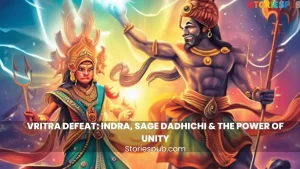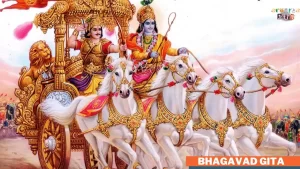The Story of Trishanku: A Tale of Power and Pride

Trishanku was the king of the Ikshvaku dynasty and ruled over the ancient city of Ayodhya in India. Despite his many flaws, such as his arrogance, pride, and lust for power and wealth, he was beloved by his people for his military prowess and his ability to defend the kingdom from enemies.
One day, Trishanku heard about a sage named Vishwamitra, who was famous for his spiritual knowledge and his ability to perform incredible feats of magic. Intrigued by the sage, Trishanku decided to invite him to his palace, hoping to learn from him and gain his favor.
Vishwamitra accepted the invitation and arrived at Trishanku’s palace, where he was welcomed with great honor and respect. Trishanku asked the sage to perform a yajna, or sacred ritual, which would elevate him to the status of a demigod, allowing him to ascend to heaven in his mortal form.
At first, Vishwamitra was hesitant to perform such a ritual, as it went against the laws of nature and the will of the gods. However, Trishanku persisted in his request, and eventually, the sage relented, agreeing to perform the yajna for him.
Vishwamitra began the ritual, using his magical powers to create a new world between heaven and earth, where Trishanku would reside as a demigod. However, as the ritual progressed, the gods became angry and offended by Trishanku’s audacity and arrogance. They refused to let him enter heaven in his current form and banished him to the underworld instead.
Trishanku was devastated by this turn of events and begged Vishwamitra to intervene on his behalf. The sage used his powers to create a third world, where Trishanku would reside for eternity. This world was known as Trishanku’s Heaven, a place that was neither heaven nor earth, but somewhere in between.
there are different versions of Trishanku’s story with slight variations in the details and outcomes. However, the core message remains the same – the pursuit of power and status can lead to downfall and despair, while humility and gratitude can bring true fulfillment and happiness.
In some versions of the story, Trishanku was not an outcast king but rather a righteous and virtuous ruler. In these versions, he was cursed by a powerful sage for refusing to allow him to marry his daughter. The curse caused Trishanku to be suspended upside down between heaven and earth, unable to enter either realm.
In other versions, Trishanku’s story is linked to the famous Hindu epic, the Ramayana. According to these versions, Trishanku was a descendant of Lord Rama’s brother, Bharata. He was known for his arrogance and pride, and his desire to ascend to heaven in his mortal form.
In these versions, Trishanku approached the sage Vishwamitra, hoping to gain his favor and ascend to heaven. Vishwamitra was initially hesitant but eventually agreed to help him. He used his magical powers to create a new world between heaven and earth, where Trishanku could reside as a demigod.
However, the gods became angry and offended by Trishanku’s audacity and refused to let him enter heaven in his current form. Vishwamitra then created a third world, similar to the earlier version, where Trishanku could reside for eternity.
In some versions, Trishanku’s story ends tragically, with him remaining an outcast king and never achieving true happiness or fulfillment. In others, he eventually learns the error of his ways and becomes a humble and virtuous ruler, earning the respect and admiration of his people.
Despite this seemingly miraculous outcome, Trishanku was still considered an outcast king, rejected by both the gods and his fellow mortals. He lived the rest of his life in isolation and sadness, never fully understanding the consequences of his actions or the true meaning of his existence.
Despite this seemingly miraculous outcome, Trishanku was still considered an outcast king, rejected by both the gods and his fellow mortals. He lived the rest of his life in isolation and sadness, never fully understanding the consequences of his actions or the true meaning of his existence.
Trishanku’s story is significant in Hindu mythology because it highlights the dangers of arrogance and pride, and the consequences of defying the natural order of things. It also underscores the importance of humility, respect, and obedience to higher powers, whether they be gods, sages, or the laws of nature.
Trishanku is a figure in Indian literature and art who is often portrayed as a tragic victim of his own ego and ambition. His story serves as a cautionary tale, reminding us of the dangers of hubris and the importance of living in harmony with the natural world and the divine order.
Trishanku’s story teaches us many lessons about the importance of humility, respect, and obedience. It warns us of the dangers of pride, arrogance, and disobedience, and of the consequences that our actions can have on ourselves and others.
Moreover, Trishanku’s story is also relevant to modern-day life and society. It reminds us of the need to live in harmony with nature, to respect the laws of nature, and to be mindful of our impact on the environment. It teaches us the importance of humility and gratitude, and of recognizing and accepting our place in the world.
Furthermore, Trishanku’s story can also serve as a lesson in leadership and governance. It highlights the dangers of unchecked power and the need for leaders to act with humility, respect, and a sense of duty to their people and the environment. It underscores the importance of using power wisely and responsibly, and of putting the needs of others before our own desires for personal gain and glory.Trishanku’s story has different versions, but the main elements remain the same – his arrogance and pride led him to desire to ascend to heaven in his mortal form, against the will of the gods. In some versions, he was cursed for refusing to allow a powerful sage to marry his daughter. In others, he approached the sage Vishwamitra to gain his favor and ascend to heaven.
In all versions, Vishwamitra created a new world between heaven and earth, where Trishanku would reside as a demigod. However, the gods became angry and refused to let him enter heaven in his current form, resulting in Trishanku being banished to a third world known as Trishanku’s Heaven, where he would reside for eternity.
Trishanku’s story is significant in Hindu mythology, as it highlights the dangers of arrogance and pride and the consequences of defying the natural order of things. It also emphasizes the importance of humility, respect, and obedience to higher powers, whether they be gods, sages, or the laws of nature.
In conclusion, Trishanku’s story is a timeless tale with important lessons for us all. It reminds us of the dangers of unchecked ambition and the importance of humility, respect, and obedience. It teaches us about the consequences of our actions and the impact they can have on ourselves and others. Finally, it serves as a reminder of the need to live in harmony with nature and the divine order and to use our power and influence wisely and responsibly.In conclusion, the story of Trishanku is a timeless tale of the dangers of pride and arrogance, and the importance of humility, respect, and obedience. It serves as a reminder of the consequences of our actions, and the impact they can have on ourselves and the world around us.
Through Trishanku’s story, we can learn valuable lessons about leadership, governance, and the need to live in harmony with nature and the divine order. Ultimately, his story can inspire us to live a more mindful, humble, and fulfilling life, one that is guided by the principles of wisdom, compassion, and gratitude.
Trishanku story FAQ
What is the significance of Trishanku's story?
Trishanku's story highlights the importance of humility, respect, and obedience, and warns us of the dangers of pride, arrogance, and disobedience. It teaches us about the consequences of our actions and the impact they can have on ourselves and others.
How did Trishanku become an outcast king?
In some versions of Trishanku's story, he was cursed by a powerful sage for refusing to allow him to marry his daughter. In others, he approached the sage Vishwamitra to gain his favor and ascend to heaven, against the will of the gods.
What is Trishanku's relationship with Vishwamitra?
Trishanku approached the sage Vishwamitra to gain his favor and ascend to heaven. Vishwamitra was initially hesitant but eventually agreed to help him. He used his magical powers to create a new world between heaven and earth, where Trishanku could reside as a demigod.
What is Trishanku's fate in the end?
In some versions of Trishanku's story, he remains an outcast king and never achieves true happiness or fulfillment. In others, he eventually learns the error of his ways and becomes a humble and virtuous ruler, earning the respect and admiration of his people.
What are the different versions of Trishanku's story?
Trishanku's story has different variations, but the core elements remain the same - his arrogance and pride led him to desire to ascend to heaven in his mortal form, against the will of the gods. The details vary regarding why he was cursed and how he approached Vishwamitra.
What is the moral of Trishanku's story?
The moral of Trishanku's story is the pursuit of power and status can lead to downfall and despair, while humility and gratitude can bring true fulfillment and happiness. It warns us of the dangers of unchecked ambition and the importance of living in harmony with nature and the divine order.
How is Trishanku portrayed in Indian literature and art?
Trishanku is often portrayed in Indian literature and art as a tragic figure, a victim of his own ego and ambition. His story is a popular subject for writers and artists who seek to explore its many facets and meanings.
What lessons can we learn from Trishanku's story?
Trishanku's story teaches us about the importance of humility, respect, and obedience, and warns us of the dangers of pride, arrogance, and disobedience. It also highlights the consequences of our actions and the impact they can have on ourselves and others.
How does Trishanku's story relate to modern-day life and society?
Trishanku's story is relevant to modern-day life and society. It serves as a reminder of the need to live in harmony with nature, to respect the laws of nature, and to be mindful of our impact on the environment. It also teaches us the importance of humility, respect, and gratitude, and of recognizing and accepting our place in the world.
Hey kids, how much did you like The The Story of Trishanku: A Tale of Power and Pride? Please share your view in the comment box. Also, please share this story with your friends on social media so they can also enjoy it, and for more such Hindu Mythology, , please bookmark storiespub.com.
Check out other stories that we have:





